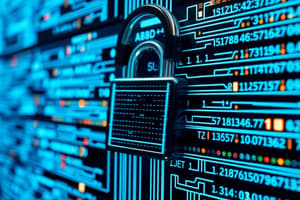Podcast
Questions and Answers
ما هو دور "Buffer"؟
ما هو دور "Buffer"؟
- تحويل البيانات من تنسيق إلى آخر.
- تخزين البيانات المُتبادلة بين النظام والعديد من الأجهزة. (correct)
- تنظيم سلسلة من الأوامر لتنفيذها بشكل تسلسلي.
- التعامل مع الأخطاء في نقل البيانات.
ما هي الوظيفة الأساسية لـ "Device driver"؟
ما هي الوظيفة الأساسية لـ "Device driver"؟
- تنظيم البيانات قبل نقلها إلى المعالج المركزي.
- ضبط وتشغيل الأجهزة الملحقة بالكمبيوتر.
- توفير واجهة بين النظام ووحدات الإدخال/الإخراج. (correct)
- إدارة الاتصالات بين وحدة المعالجة المركزية ووحدة الإدخال/الإخراج.
ماذا يعني "Bus" في سياق الكمبيوتر؟
ماذا يعني "Bus" في سياق الكمبيوتر؟
- برنامج خاص يتحكم في جميع أجزاء الكمبيوتر.
- شبكة من الوصلات التي تربط بين الأجزاء المختلفة في الكمبيوتر. (correct)
- مساحة تخزين تستخدم لإدارة الأوامر.
- طريقة لتنظيم البيانات داخل ملف.
ما هو الهدف من استخدام "Controller"؟
ما هو الهدف من استخدام "Controller"؟
ما هو دور "Software" في نظام الكمبيوتر؟
ما هو دور "Software" في نظام الكمبيوتر؟
ما هي الفائدة الرئيسية لتخزين المعلومات في ذاكرة التخزين المؤقت؟
ما هي الفائدة الرئيسية لتخزين المعلومات في ذاكرة التخزين المؤقت؟
ما هي العواقب المحتملة لاستخدام ذاكرة التخزين المؤقت كبيرة الحجم؟
ما هي العواقب المحتملة لاستخدام ذاكرة التخزين المؤقت كبيرة الحجم؟
ما هي تقنية "multitasking" في سياق ذاكرة التخزين المؤقت؟
ما هي تقنية "multitasking" في سياق ذاكرة التخزين المؤقت؟
لماذا يُفضل عدم تخزين البيانات في ذاكرة التخزين المؤقت عند تحسين كفاءة المعالج؟
لماذا يُفضل عدم تخزين البيانات في ذاكرة التخزين المؤقت عند تحسين كفاءة المعالج؟
ما هي العلاقة بين "الذاكرة التخزين المؤقت " و "سرعة الوصول إلى البيانات؟"
ما هي العلاقة بين "الذاكرة التخزين المؤقت " و "سرعة الوصول إلى البيانات؟"
ما هو نوع البروتوكول الذي يستخدم في Napster و Gnutella؟
ما هو نوع البروتوكول الذي يستخدم في Napster و Gnutella؟
ما هو الهدف من استخدام central lookup في الشبكات؟
ما هو الهدف من استخدام central lookup في الشبكات؟
ما هو المفهوم الأساسي لِ Virtualization ؟
ما هو المفهوم الأساسي لِ Virtualization ؟
ما هي وظيفة VMM ؟
ما هي وظيفة VMM ؟
ما هو الفرق بين server و client ؟
ما هو الفرق بين server و client ؟
ما هو الدور الذي تلعبه node في الشبكات؟
ما هو الدور الذي تلعبه node في الشبكات؟
ما هو دور discovery protocol ؟
ما هو دور discovery protocol ؟
ما هو المفهوم الذي يصف قيام جهاز واحد بتشغيل عدة أنظمة تشغيل؟
ما هو المفهوم الذي يصف قيام جهاز واحد بتشغيل عدة أنظمة تشغيل؟
ما هو الغرض من عملية إدارة الذاكرة؟
ما هو الغرض من عملية إدارة الذاكرة؟
أي مما يلي ليس جزءًا من عملية إدارة الذاكرة؟
أي مما يلي ليس جزءًا من عملية إدارة الذاكرة؟
ما هو الغرض من "deadlock handling" في "process synchronization"؟
ما هو الغرض من "deadlock handling" في "process synchronization"؟
ما هو الفرق بين "process communication" و "process synchronization"؟
ما هو الفرق بين "process communication" و "process synchronization"؟
ما هو الدور الذي تلعبه "memory management" في "process synchronization"؟
ما هو الدور الذي تلعبه "memory management" في "process synchronization"؟
ما هو نظام التشغيل غير متعدد المهام؟
ما هو نظام التشغيل غير متعدد المهام؟
ما هو الفرق الرئيسي بين أنظمة متعددة المهام (multitasking) وأنظمة تعدد البرمجة (multiprogramming)؟
ما هو الفرق الرئيسي بين أنظمة متعددة المهام (multitasking) وأنظمة تعدد البرمجة (multiprogramming)؟
ما هو دور جهاز التوقيت (Timer) في أنظمة التشغيل؟
ما هو دور جهاز التوقيت (Timer) في أنظمة التشغيل؟
ما هي ميزة استخدام تقنية شريحة الوقت (Quantum) في أنظمة متعددة المهام؟
ما هي ميزة استخدام تقنية شريحة الوقت (Quantum) في أنظمة متعددة المهام؟
ما هي وظيفة إدارة الذواكر في نظام التشغيل؟
ما هي وظيفة إدارة الذواكر في نظام التشغيل؟
ما هي الوظيفة الأساسية لعملية إدارة الملفات في نظام التشغيل؟
ما هي الوظيفة الأساسية لعملية إدارة الملفات في نظام التشغيل؟
ما هو الفرق بين عملية الإنهاء العادي (Normal termination) للعملية و عملية الإنهاء القسري (Abnormal termination)؟
ما هو الفرق بين عملية الإنهاء العادي (Normal termination) للعملية و عملية الإنهاء القسري (Abnormal termination)؟
ما هو دور إدارة الأجهزة في نظام التشغيل؟
ما هو دور إدارة الأجهزة في نظام التشغيل؟
ما هو دور الأمن والحماية في نظام التشغيل؟
ما هو دور الأمن والحماية في نظام التشغيل؟
ما هو نظام التشغيل الذي يمكنه تشغيل أكثر من برنامج واحد في وقت واحد؟
ما هو نظام التشغيل الذي يمكنه تشغيل أكثر من برنامج واحد في وقت واحد؟
ما هو الوقت الذي يتم تخصيصه لكل عملية (Process) في نظام التشغيل متعدد المهام؟
ما هو الوقت الذي يتم تخصيصه لكل عملية (Process) في نظام التشغيل متعدد المهام؟
ما هو الفرق الرئيسي بين نظام التشغيل متعدد المهام (Multitasking) ونظام التشغيل متعدد المستخدمين (Multiuser)؟
ما هو الفرق الرئيسي بين نظام التشغيل متعدد المهام (Multitasking) ونظام التشغيل متعدد المستخدمين (Multiuser)؟
ما هي أنواع الإنهاء العادي للعملية (Process termination)؟
ما هي أنواع الإنهاء العادي للعملية (Process termination)؟
ما هو الفرق بين إدارة الذاكرة (Memory management) وإدارة الملفات (File management)؟
ما هو الفرق بين إدارة الذاكرة (Memory management) وإدارة الملفات (File management)؟
ما هو نظام التشغيل DOS؟
ما هو نظام التشغيل DOS؟
ما هي الفائدة الرئيسية من استخدام "Security" في "Computer Systems"؟
ما هي الفائدة الرئيسية من استخدام "Security" في "Computer Systems"؟
ما هو الغرض من استخدام "User IDs" و "Security IDs" في نظام الحماية والأمان؟
ما هو الغرض من استخدام "User IDs" و "Security IDs" في نظام الحماية والأمان؟
ما هي الفائدة من استخدام "Group IDs" في أنظمة الحماية والأمان؟
ما هي الفائدة من استخدام "Group IDs" في أنظمة الحماية والأمان؟
ما هو الغرض من استخدام "Privilege escalation" في أنظمة الحماية والأمان؟
ما هو الغرض من استخدام "Privilege escalation" في أنظمة الحماية والأمان؟
ما هي وظيفة "Kernel Data Structures" في "Kernel"؟
ما هي وظيفة "Kernel Data Structures" في "Kernel"؟
ما هي الفائدة من استخدام "Hash function" في "Kernel Data Structures"؟
ما هي الفائدة من استخدام "Hash function" في "Kernel Data Structures"؟
ما هو الغرض من استخدام "Bitmap" في "Kernel Data Structures"؟
ما هو الغرض من استخدام "Bitmap" في "Kernel Data Structures"؟
ما هي الفائدة الرئيسية لبيئة الحوسبة "Traditional computing environments"؟
ما هي الفائدة الرئيسية لبيئة الحوسبة "Traditional computing environments"؟
ما هي الفرق الأساسي بين "Mobile Computing Environments" و "Traditional Computing Environments"؟
ما هي الفرق الأساسي بين "Mobile Computing Environments" و "Traditional Computing Environments"؟
ما هي الفرق الأساسي بين "Client-Server" و "Peer-to-Peer"؟
ما هي الفرق الأساسي بين "Client-Server" و "Peer-to-Peer"؟
ما هي المنصات الشائعة لـ "Mobile Computing Environments"؟
ما هي المنصات الشائعة لـ "Mobile Computing Environments"؟
ما هو الغرض الرئيسي لبيئة الحوسبة "Cloud Computing"؟
ما هو الغرض الرئيسي لبيئة الحوسبة "Cloud Computing"؟
ما هو الفرق الأساسي بين "Thin Clients" و "Network Computers"؟
ما هو الفرق الأساسي بين "Thin Clients" و "Network Computers"؟
ما هي الخصائص الرئيسية لأنظمة "Real-Time Embedded Systems"؟
ما هي الخصائص الرئيسية لأنظمة "Real-Time Embedded Systems"؟
Flashcards
برامج التحكم
برامج التحكم
برامج تربط الجهاز بالنظام وتدير وظائفه.
جهاز المدخل/المخرج
جهاز المدخل/المخرج
الأجهزة التي تتفاعل مع الحاسوب لتبادل المعلومات.
التحكم في البيانات
التحكم في البيانات
إدارة تدفق البيانات بين المعالج والأجهزة.
حافلة البيانات
حافلة البيانات
Signup and view all the flashcards
وحدة المعالجة المركزية (CPU)
وحدة المعالجة المركزية (CPU)
Signup and view all the flashcards
تزامن العمليات
تزامن العمليات
Signup and view all the flashcards
اتصال العمليات
اتصال العمليات
Signup and view all the flashcards
معالجة الموت
معالجة الموت
Signup and view all the flashcards
إدارة الذاكرة
إدارة الذاكرة
Signup and view all the flashcards
معالجة التعليمات
معالجة التعليمات
Signup and view all the flashcards
Caching
Caching
Signup and view all the flashcards
Multitasking
Multitasking
Signup and view all the flashcards
تأثير التخزين المؤقت
تأثير التخزين المؤقت
Signup and view all the flashcards
أخطاء إدخال البيانات
أخطاء إدخال البيانات
Signup and view all the flashcards
رغبة الاستفادة من البيانات
رغبة الاستفادة من البيانات
Signup and view all the flashcards
أنظمة البرمجة المتعددة
أنظمة البرمجة المتعددة
Signup and view all the flashcards
المشاركة الزمنية
المشاركة الزمنية
Signup and view all the flashcards
جدولة المعالج
جدولة المعالج
Signup and view all the flashcards
إدارة الملفات
إدارة الملفات
Signup and view all the flashcards
إدارة الأجهزة
إدارة الأجهزة
Signup and view all the flashcards
إدارة التخزين الكتلي
إدارة التخزين الكتلي
Signup and view all the flashcards
إدارة المدخلات والمخرجات
إدارة المدخلات والمخرجات
Signup and view all the flashcards
الأخطاء الفادحة
الأخطاء الفادحة
Signup and view all the flashcards
الذاكرة الافتراضية
الذاكرة الافتراضية
Signup and view all the flashcards
انتهاء العملية
انتهاء العملية
Signup and view all the flashcards
العمليات
العمليات
Signup and view all the flashcards
المهام المتعددة
المهام المتعددة
Signup and view all the flashcards
التجزئة
التجزئة
Signup and view all the flashcards
سير العمل
سير العمل
Signup and view all the flashcards
node
node
Signup and view all the flashcards
central lookup
central lookup
Signup and view all the flashcards
discovery protocol
discovery protocol
Signup and view all the flashcards
Voice over IP (VoIP)
Voice over IP (VoIP)
Signup and view all the flashcards
Virtualization
Virtualization
Signup and view all the flashcards
VMM (مدير الآلات الافتراضية)
VMM (مدير الآلات الافتراضية)
Signup and view all the flashcards
Linux
Linux
Signup and view all the flashcards
خدمات الشبكة
خدمات الشبكة
Signup and view all the flashcards
برنامج تشغيل الجهاز
برنامج تشغيل الجهاز
Signup and view all the flashcards
الحماية
الحماية
Signup and view all the flashcards
الأمان
الأمان
Signup and view all the flashcards
معرف المستخدم
معرف المستخدم
Signup and view all the flashcards
معرف المجموعة
معرف المجموعة
Signup and view all the flashcards
تصعيد الامتيازات
تصعيد الامتيازات
Signup and view all the flashcards
بنية بيانات النواة
بنية بيانات النواة
Signup and view all the flashcards
دالة التجزئة
دالة التجزئة
Signup and view all the flashcards
خدمات العميل-الخادم
خدمات العميل-الخادم
Signup and view all the flashcards
المعالجة الموزعة
المعالجة الموزعة
Signup and view all the flashcards
الأنظمة المضمنة
الأنظمة المضمنة
Signup and view all the flashcards
الحوسبة السحابية
الحوسبة السحابية
Signup and view all the flashcards
التوزيع الشبكي
التوزيع الشبكي
Signup and view all the flashcards
الأنظمة الحقيقية
الأنظمة الحقيقية
Signup and view all the flashcards
Study Notes
Introduction to Operating Systems
- Operating Systems (OS) act as an intermediary between the user and the hardware.
- Key functions of an OS include running user applications and providing a convenient environment.
- An OS aims to optimize resource utilization by ensuring efficient operation.
- The Kernel is a crucial part of the OS that remains active throughout computer operation.
- System programs enhance the OS and offer user-facing services (e.g., compilers, assemblers).
- Application programs are separate from the OS, including utilities like VLC, Notepad, and games.
- Middleware software frameworks provide additional services (databases, multimedia, graphics) typically found in general-purpose OS.
- Mobile computing often integrates middleware for functionalities.
Hardware Components
- Hardware includes the central processing unit (CPU), memory, and input/output (I/O) devices.
- Adapters/Controllers connect hardware to the system. Individual devices may have controllers (sometimes integrated).
- Software Device Drivers interact with the controllers.
- Controllers often contain buffers to store data temporarily. Controllers operate independently from the main CPU.
- Interrupts enable communication between the CPU and external devices. Devices signal the CPU when they're ready to transfer data.
Interrupts
- Interrupts are signals from hardware or software to the CPU to perform a critical action.
- Interrupt service routines (ISRs) handle interrupts, transferring control to the appropriate functions.
- Hardware interrupts originate from hardware devices, while software interrupts include exceptions like errors (e.g., division by zero) or system calls.
Interrupt Timeline
- CPU activity is represented by peaks, while valleys represent I/O activity.
- I/O device activity corresponds to data transfers.
- Direct Memory Access (DMA) handles data transfer independently to the CPU.
Memory Hierarchy
- Registers, cache, main memory, magnetic disks, optical disks, and magnetic tapes make up the hierarchy.
- Registers have very high speed and low capacity.
- Cache is faster than main memory.
- Main memory is faster than secondary storage.
- Secondary storage is the slowest but largest capacity storage.
- Volatile memory loses data when the power is off (e.g., registers, cache, RAM).
- Non-volatile memory retains data when the power is off (e.g., magnetic disks, optical drives, magnetic tapes).
System Calls Interface
- The system call interface enables programs to request services from the OS.
- It functions as a set of codes used for system calls.
- System calls use special codes to initiate actions, forwarding requests and data to the kernel through registers.
Single and Multiprocessing
- Single processor systems handle only one task at a time.
- Multiprocessor systems (tightly coupled systems) often have multiple CPUs sharing resources.
- Parallel systems are a specific type of multiprocessor system.
Symmetric/Asymmetric Multiprocessing
- Symmetric multiprocessing (SMP) treats all processors equally, coordinating tasks among them.
- Asymmetric multiprocessing assigns specific tasks to particular processors, with one acting as primary.
Multiprogramming vs. Multitasking
- Multiprogramming manages multiple jobs in memory to improve CPU utilization.
- Multitasking (timesharing) allows users to interact with multiple programs simultaneously, allowing each program a short slice of processor time.
- Multiprogramming is a component of multitasking.
Kernel Data Structures
- Data structures in the kernel, such as linked lists, binary search trees, and hash maps, significantly affect system performance.
Computing Environments
- Traditional computing environments consist of stand-alone computers.
- Mobile computing involves devices connected wirelessly.
- Client-server systems feature centralized servers.
- Peer-to-peer systems connect similarly-enabled devices.
- Cloud computing utilizes virtualization and distributed resources.
- Real-time embedded systems necessitate precise timing for critical applications.
- Distributed computing networks connect multiple devices.
Operating System Functions
- Process Management: Manages processes, their creation, and their termination.
- Memory Management: Controls memory allocation for processes.
- File-System Management: Handles directory structures and file operations.
- Mass-Storage Management: Oversees secondary storage.
- I/O Management: Provides a common interface for device drivers.
- Protection and Security: Enables access control and system security.
Studying That Suits You
Use AI to generate personalized quizzes and flashcards to suit your learning preferences.




